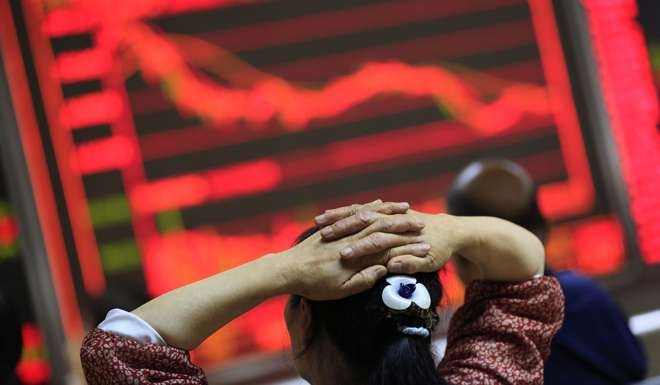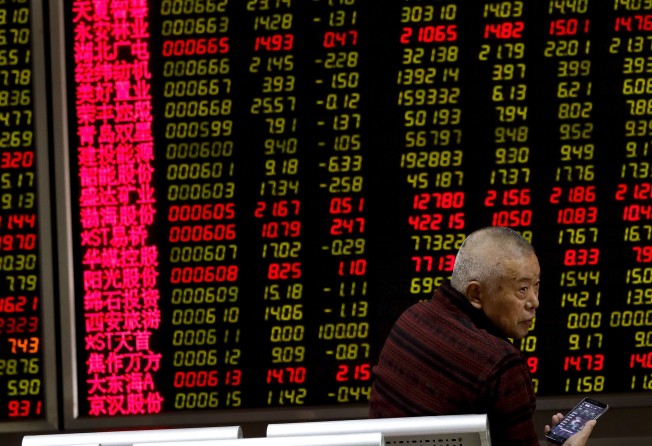
Mainland China stocks rebound on insurance fund buys and signs of stable bond market

Mainland China’s A-share markets shrugged off early losses to close higher on Monday after speculative stocks favoured by insurance funds rebounded in late trading.
Hong Kong’s stock market is closed on Monday and Tuesday for Christmas holidays.
The Shanghai Composite Index closed 0.4 per cent or 12.42 points higher at 3,122.57 on Monday. The CSI 300 Index, which tracks large companies listed in Shanghai and Shenzhen, added 0.45 per cent to 3,322.40.
The Shenzhen Component Index was up 0.33 per cent to 10,233.42 while the Nasdaq-like ChiNext increased to 1,974.01, up 0.48 per cent.
Shares targeted by insurance funds gained late on Monday, rebounding from sharp declines early this month triggered by Chinese regulators’ tightening of rules.
Shenzhen listed China Vanke jumped 1.72 per cent to 20.65 yuan, while Gree Electric Appliances added 2.2 per cent to 24.62 yuan. CSG Holding climbed 0.44 per cent to 11.41 yuan.
Insurers also increased on Monday, with Shanghai listed Ping An Insurance Group up 1.12 per cent to 35.12 yuan while China Life’s A shares closed 2.63 per cent higher at 24.23 yuan.
Shenzhen-listed Shanxi Securities gained 5.13 per cent to 12.30 yuan while Shanghai-listed Sinolink Securities rose 2.33 per cent to 13.15 yuan.
Trading volume in Shanghai, however, continued to shrink during the festive season, hitting the lowest level in nearly two months as investor sentiment is always weaker when the Chinese year-end holidays approach.
Low trading volumes were also due to the fact that capital markets faced a liquidity shortage on Monday as the People’s Bank of China, through a series of open market operations, withdrew around 70 billion yuan (HK$78.2 billion) of capital.

Stability in the bond markets on Monday helped the recovery in China’s stock market.
Benchmark five-year treasury futures for March delivery rose 0.05 per cent on Monday, recovering from a 0.31 per cent drop at the market opening. The 10-year treasury futures for March delivery were flat, while the benchmark 10-year government bond yield fell back to 3.145 per cent. Bond prices move inversely to yield.
“We will closedly monitor the liquidity conditions and bond market,” said CICC analysts led by Eva Yi, who added that the near term focus will be on China’s important new economic data. November’s industrial enterprise profit and revenue data will be released on December 27, while December’s manufacturing and service PMI data will be released on January 1.
Industrial Securities analysts led by Wang Delun warned that investors should be wary of tightening liquidity in the mainland market in the first quarter of 2017 as the Chinese government is taking a more conservative stance towards monetary policy and is deleveraging financial markets.
Chinese President Xi Jinping is comfortable seeing China’s economic growth fall below 6.5 per cent, Bloomberg reported last week.
Meanwhile, there is also an expectation that China’s inflation rate will climb as global markets expect more rate rises by the US Federal Reserve, the Industrial Securities analysts said.
“Stock benchmarks therefore are facing downside pressure in the first quarter of 2017,” they said, “But it’s possible to see the government turn its focus back to economic growth in the second quarter as property investment growth slows down and domestic demand turns weaker.”
The onshore yuan strengthened 0.06 per cent or 38 basis points to 6.94518 per US dollar at 4.55 pm on Monday. The onshore yuan has been hovering around the level of 6.95 for more than a week. Market watchers see 7 as a critical psychological threshold.
The Chinese central bank set the yuan reference rate at 6.9459 against the US dollar, 4 basis points stronger than last Friday.